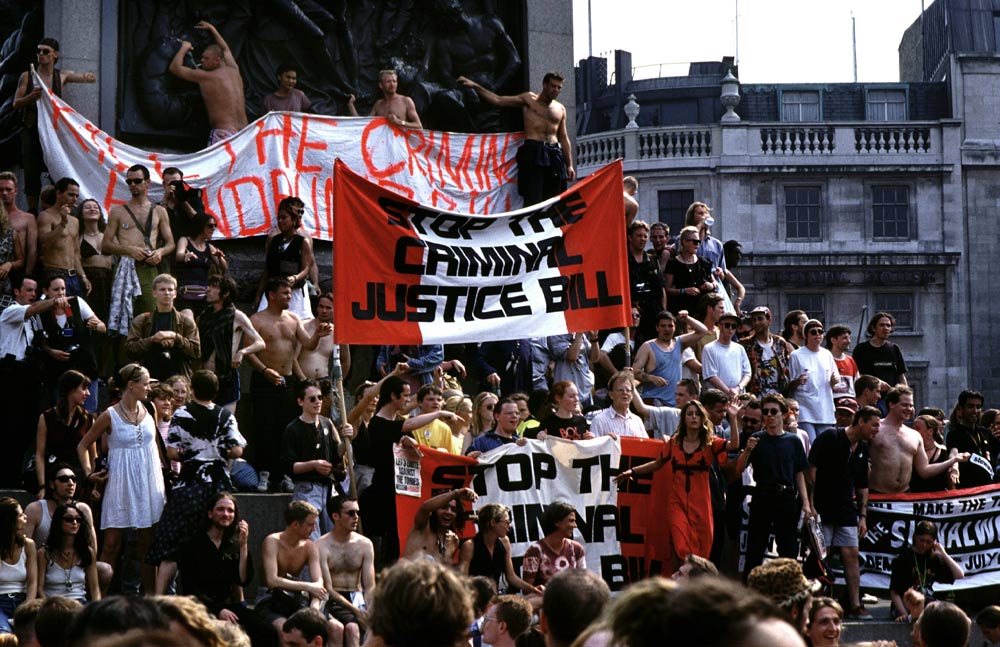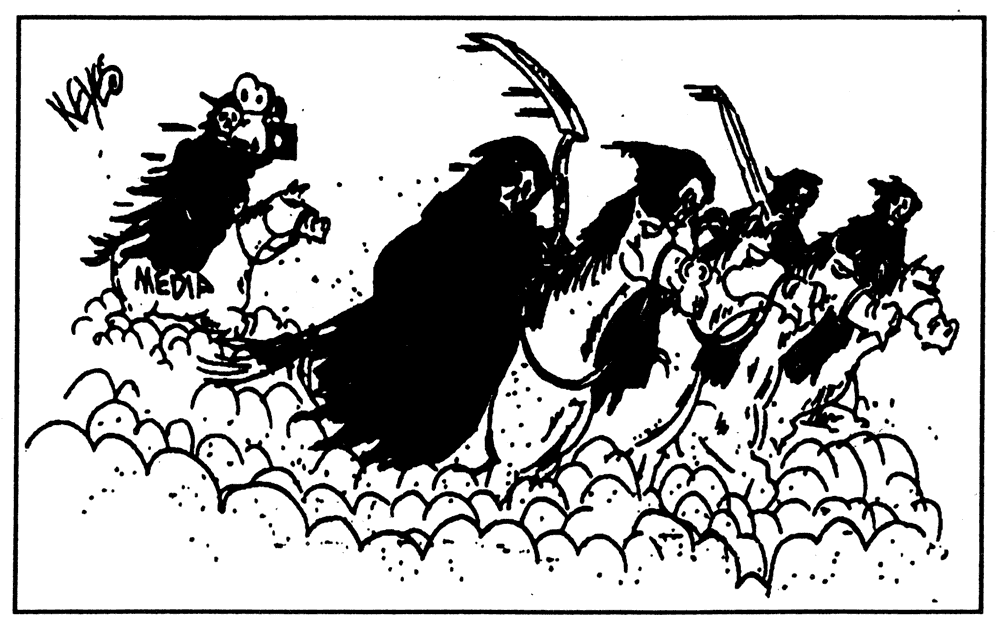
NEWS Of The SKEWS
A look at the news, opinions and skew-whiffs, as presented by the British press.
Squall 8, Autumn 1994, p.14.
“Protest mob in siege of Downing Street,” ran the headline in the Daily Mail on the day after the CJB demonstration on 24th July.
“Mob”?.... You have to get to paragraph eight (the small print) to find:
“Scotland Yard, which dispatched 2,000 officers to deal with the march said: ‘The people at Downing Street were a very small minority of the March which in the main passed peacefully and without incident’.” But in this case the Mail wasn’t interested in what the police had to say. Three fifths of the page devoted to the demonstration consisted of three photographs concentrating only on the 15 minute fracas that took place outside Downing St. One fifth consisted of the headline and one fifth the text. (The last fifth was an advert for mobile phones).
A seven hour forceful, yet predominantly peaceful, demonstration represented in the media by 15 minutes of news-juicy violence. Forget the police’s “in the main passed peacefully” conclusions, the Mail’s leader column talked only of “Facing up to the mob” at “yesterdays ugly demo”.
Now if it was the case that the Daily Mail were alone with their gross misrepresentation, we could simply conclude that it was the result of the Mail’s well-known disposition to report only those angles that suit its own underlying agenda, regardless of the event. But they weren’t the only ones. Every national newspaper in Britain proved itself to be a party to a blatant misrepresentation that seriously calls into question the media’s role as instigators of violence. The photographs of the event say it all:
The three in the Daily Mail, three in The Times, the large black and white on the cover of The Guardian, the large colour photo on the front cover of the Independent. Four in The Sun, three in the Daily Express (including front cover) and one in the Daily Mirror.
Every single shot was of the 15 minute fracas outside Downing Street and not one single newspaper printed any other picture. Never mind the 50,000 people on the March, never mind the array of speakers in Trafalgar Square, never mind a thousand other photo opportunities - violence sells newspapers.

Take a look at the captions that accompanied the photos. “Confrontation: Violence breaks out.” - Daily Mail. “Flashpoint - Ranks of riot police clashed.” - Daily Mirror. “Faces of Hate: Demonstrators harangue riot police” and “Mob rule: Protesters threaten to break in” - Daily Express. “Defiant: A girl protester (with naked midriff) throws a stick” - The Sun. “Protesters at the gates: Police drove them off three times.” - Daily Telegraph. “A demonstrator astride the gates taunt police. Other protesters hurled missiles.” - The Guardian.
Of the many non-violent direct action stewards that were present on the March, there was scant mention. “Despite some of the crowd shouting ‘No violence’, fights broke out,” reported The Guardian.
“As the mob became angry again, stewards shouted ’Keep it peaceful, keep it moving’,” mentioned The Times, but not before it had titillated its readers with “demonstrators engaged in hand to hand fighting with the police.” Ironically, the accompanying photograph of the fracas in The Times, shows Bridgette from the Freedom Network laying her hand on the arm of an angry protester, with one of the 20,000 ‘Non Violence’ stickers given out on the day, stuck to her chest.
The Times, of course, passed by the opportunity to comment on this however, preferring to scoff at the “clusters of hippies and new age travellers that smoked cannabis openly and shouted abuse at passers-by and police”.
Along similar lines came an LBC reporter who cornered one of SQUALL’s editors for an interview.
“A lot of people seem to be mucking about in the fountains. Do you think they know what the Bill is actually about?” To which he received a full reply. But pursuing his pre-determined angle, he continued: “I’ve seen a lot of drugs about today. Do you think this detracts from your cause?” To which he was told: “I know a lot of very important questions that a radio-journalist might ask about the Bill and this demo but this isn’t one of them.”
The completely impartial journalist offered the usual excuse behind which to retreat: “I need to ask these questions for a balanced report”. But with breath direct from a brewery, an alcohol vaso-dilated face and a shaky stance reflective of his journalistic angles, he was asked: “We’ve seen a lot of journalists mucking about today with pre-determined angles. Do you think they know what this Bill is actually about?” He promptly left to pursue his malicious folly elsewhere.
The Independent’s front cover provided the 'begging metaphor’ for the media’s role in provoking violence. Above the front page photograph of the fracas, was an article on Northern Ireland; the headline said “Sinn Fein Shuns Peace”. Of course the bottom line for all terrorist organisations is that they have resorted to violence because no-one listens to the cause, unless it involves violence. By continually ignoring peaceful demonstrations and rewarding the violently inclined with coverage, despite the fact that they were vastly in the minority, the media become its perpetrators.
Despite this however, the commitment to non-violent direct action continues. If the Criminal Justice Bill goes through, as it looks certain to do, peaceful demonstrations will actually be outlawed and then where will the people seek expression for their political dis-satisfactions? If there is a consequent upsurge in the amount of violence, it is not just the Bill itself that will be to blame. The headline should have read: “The Entire Media Shuns Peace.”
If you were to meet an honest editor he/she would tell you that peace doesn't sell; violence does.
So if it's down to market forces, who then is responsible for the supply on demand?
Related Articles
News Of The Sqews - Marathon trawl through the media - Squall 6 - Spring 1994
Click here for a list of articles by SQUALL about the Criminal Justice Act and Public Order Act 1994 covering: the build-up, the resistance, the counter-culture, the consequences, plus commentary of its process through Parliament.
